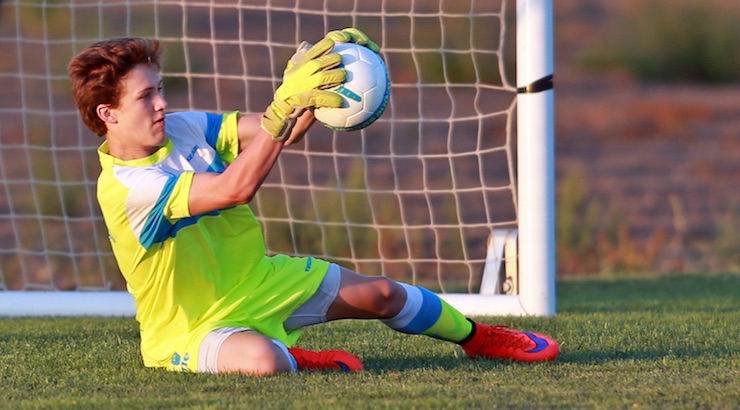Lloyd Biggs on A Reality Check on the Pay to Play Model
SoccerToday’s Columnist Lloyd Biggs is an outstanding coach whose passion and dedication for player development is highly respected and well recognized.
The question is … where will the money come from, if parents are not paying for the kids to play?
Biggs is the co-founder and Technical Director for one.Soccer Schools which trains over 3,000 youth soccer players all across the USA. Also a youth coach for Real SoCal, Lloyd holds his UEFA ‘A’, USSF ‘A” and NSCAA Premier Licenses, as well as a degree in sports science.

In the aftermath of the U.S. Men’s National Team to qualify for the FIFA World Cup — here are thoughts on what needs to change in the world of youth soccer in America.
The sleeping giant has been awoken! The recent events surrounding the US men’s national team and their failure to qualify for the 2018 world cup in Russia has stirred the masses.
Rightly so, people want change and I agree change is needed in numerous areas when we are discussing the topic of development within youth soccer here in the USA.
I have had the pleasure to be involved in numerous conversations, pre & post the disappointment that culminates when your national team underachieves.
The common theme in every discussion is the ‘Pay to Play’ model and how it is holding back soccer in the United States. It is exactly those conversations that I have listened to that have inspired me to write this article.
Note from Me – the Columnist
Firstly, let me make it clear that any and all points within this article relate back to the most talented group of players, the ones that we believe have the potential to play at the professional and international level.
Let me start by saying, I don’t have all the answers, I am not that arrogant to believe that I do. That said, I am now approaching my twenty-sixth year coaching youth soccer, the last thirteen in Southern California.
My journey has taken me from working as a youth academy coach in England in the EPL to America and being a Club Director of Coaching (DOC) for 8-years, and currently coach in the USSDA – the U.S. Soccer Development Academy. In addition to this, I have had the privilege of co-founding and being a part of building one.Soccer Schools, known by many to be one of the most intense and dynamic soccer camps here in the USA.
Since arriving in California in 2005, I have witnessed a positive shift in the overall development of players.

The Pack Mentality in Youth Soccer
I once heard a great analogy, people are a little like dogs if a pack of dogs is sleeping and one awakes and starts barking, the rest jump up and join in the barking, however, they have no idea why and who they are barking at.
I believe the Pay to Play model has become a scapegoat
Without actual thought into why and without proof that this is actually correct.
Let’s start by breaking down the many perceptions as to why the Pay to Play model is bad.
The major concern I am hearing is that the Pay to Play model in youth soccer creates exclusion based on socioeconomic backgrounds, and those who are financially stretched cannot afford to pay the club fees associated with the pay to play model. We keep hearing that we are missing talented players because of this.
“Let’s pause for a moment, think about what we are saying when we make that statement and truly review the facts in youth soccer.”
In my humble opinion, based on my experience, this perception is actually so far from the truth!
Why do you ask?
Firstly, any well-respected, well organized club has a financial aid program, allowing players to apply for scholarships.
In addition to the scholarship, the team itself always comes together to help and support the player whose family is not so fortunate financially as others. I have witnessed firsthand countless talented young players — all of whom have the desire, character, and attitude to succeed — get a free, or so vastly reduced its almost free, soccer education allowing them to achieve incredible success within the game.
Talent is often supported in the world of youth soccer.
I can’t imagine there is a player in Southern California that would not be allowed the opportunity to play at the highest level, that SoCal has to offer if such player seeks it.
The pay to play model is not the reason we are missing talented players.
For those that disagree, well I suggest you might take a trip to the pro academies in the major cities around Europe, all of which are free, then create a socioeconomic background analysis on all the players within the academies — I will say it again, these are FREE academies — and see how the percentages come out.
I have experience working within this environment, and I am confident that you would see a very similar ratio as we have here in the USA – a blend of players from lower to middle to upper socioeconomic backgrounds.

When we look at the European model from afar it is evidently very good. It’s free of charge for training & travel for those players who are fortunate enough to be selected.
The facilities and coaching are first class.
However, let us not forget the professional soccer clubs are not doing this from the goodness of their own heart — they are investing in these young players with a goal to get a return on their investment, either by creating homegrown players that play for the first team, or selling these players to other professional or youth soccer clubs.
The other popular misconception is that the youth soccer clubs are all about the money — all they want is your money.
While I agree, initially club soccer seems expensive, but let’s break down just the training sessions.

Currently, club players are training between 3-6 hours per week, without including the time of games.
Let’s go low-ball and let’s say its only 4 hours. Now, let’s take a look at how many weeks per season players are training — excluding high school age.
Then, let’s take a look at how many weeks per season players are training (excluding high school age). Let’s go with 36-weeks at 4 hours per week, so about 144 hours of training.
What does babysitting cost these days? The California Minimum Wage is now $12.00, Effective 1/2019.
I am pretty sure you understand what I am saying, when you break it down it’s a pretty good deal.
The player is not getting just a babysitter — they are getting a qualified, licensed coach whose job is to create the best possible athletic environment for the player — allowing them to grow into the best version of themselves on and off the field.
In addition to a number of hours a coach will spend with the players in training, the coach also commits to a lot of hours at weekend games. We also need to remind ourselves of the numerous other factors required to run a competitive club at a high level of quality, which allows for the development of players to the highest level.
Youth Soccer Fields and Training Facilities
A good soccer field costs money, simple as that.
Nothing is free and quality is more expensive. Clubs are not handed any free coupons — a club’s yearly facility rental expense is extremely high. A large percentage of club fees go towards training and match day field rentals.
Many clubs enter into agreements with school districts, allowing the birth of brand new turf fields that are used by the entire community. A turf field costs in the region of a cool $1,000,000.
Supporting Cast for Youth Soccer Developing Players
The evolution of soccer at the youth level has brought about an increased level of professionalism. It is simply not possible in today’s climate to run a professional club without what I will call the supporting cast.
The Role of Director of Coaching in Youth Soccer
Usually, the person within this role has a vast amount of experience from years of working in the field of soccer. Directors of Coaching are highly educated in the game of soccer and educating players.
Like any other professional who is working in their chosen field, they should be compensated for their knowledge and work.
Youth Soccer Club Administrator
Again, the evolution of the game at the youth level has created a mountain of paperwork. Clubs need administrators to help serve the families within the club. Show me any organization who that is unprepared behind the scenes and I will show you a poor organization that is badly run and offers — at best — an average experience to its community.
Specialist Youth Soccer Coaches
All respected programs now have Goalkeeper coaches and improved sports science support.
If we want our youth players to develop, they need to be properly supported by the appropriate supporting cast.
Above are just three very important roles which are vital for any club to create a professional environment which is not only expected but required, to help players become the best they can be!
The Professional Club Coach in Youth Soccer
Take note, I am discussing the coach who is working at the highest level of the youth game, at top level youth soccer clubs and in the USSDA program. For the most part, these coaches have been in the trenches for many years, and are highly experienced working with youth soccer players.
Players at this level deserve coaches who are not only experienced but also highly qualified — many coaches now have the USSF A license. These coaches have a real love and passion for nurturing talent and helping players become the best version of themselves.
Should the person I describe here not get compensated for their knowledge and time?
I am sure you see my point: to be professional in what you do, to create the very best environment for development, it takes money!
The question is where will that money come from if parents are not paying for the American youth soccer club model?
I believe it is the responsibility of the MLS clubs to provide a free soccer education — and, as far as I am aware, almost all are fully funded academies in the USSDA set up.
Food for thought: While the environment of the college game can produce players for the MLS, is it naïve to think that we can create players who can compete on the very biggest stage of world football via a college environment?
For soccer in the USA to move in the direction allowing this country to compete on the world stage — we must begin to move away from the MLS draft.
Colleges are academic institutions whose primary responsibility is for the student-athletes to gain an education and a degree – not become a world-class player.
The good news is we are getting there!
As I have stated, most if not all MLS clubs now have fully funded U.S. Soccer Development Academies. We have begun to create more homegrown players that are choosing to accept the challenge to become a professional, rather than go to college. In my opinion, this is a step in the right direction.
In conclusion, it was the hope of this article to provoke real thought and improved discussion concerning the Pay to Play model.









